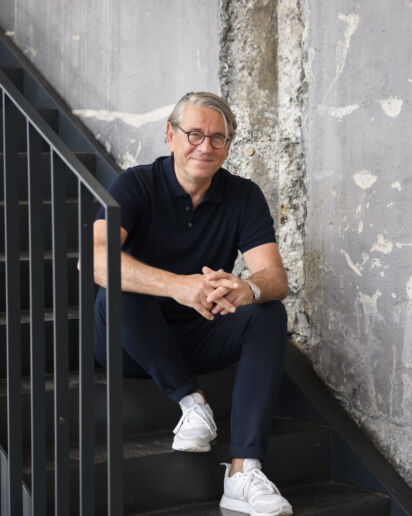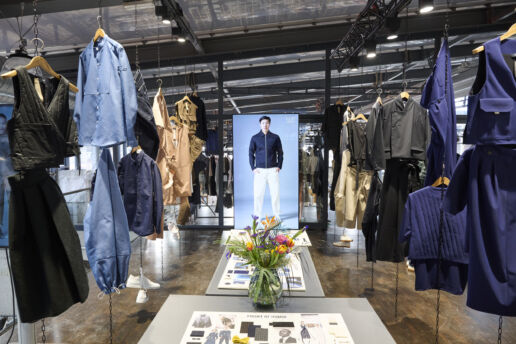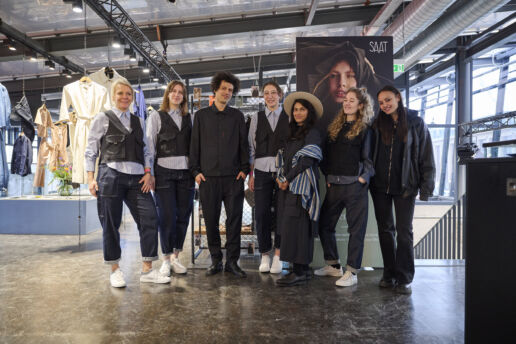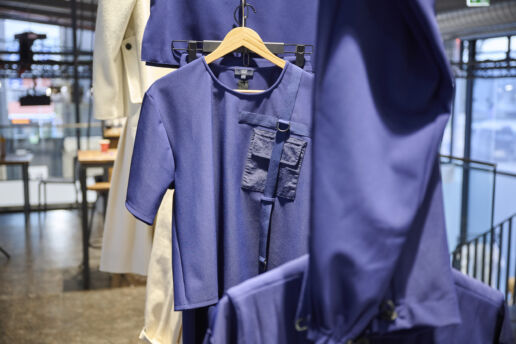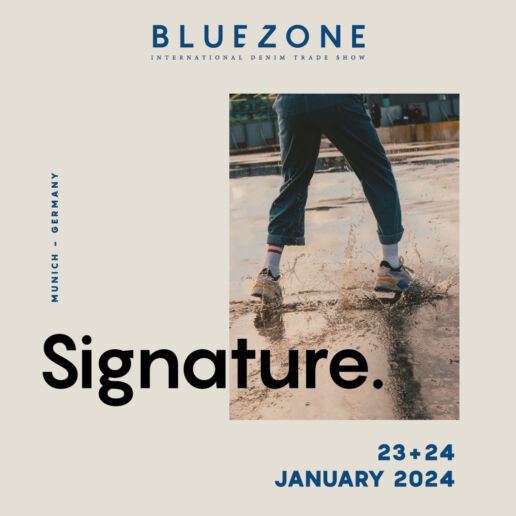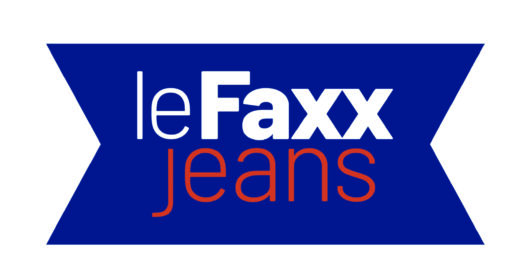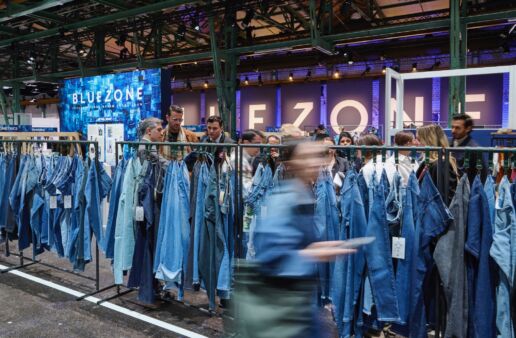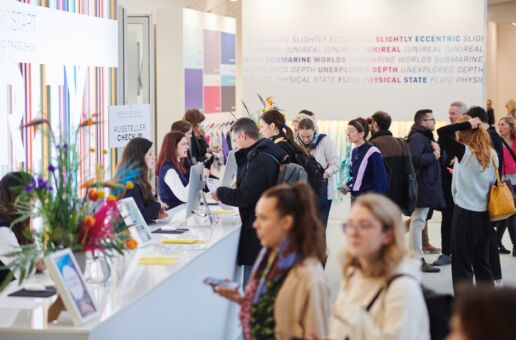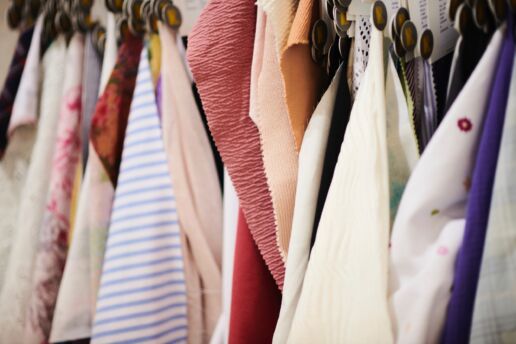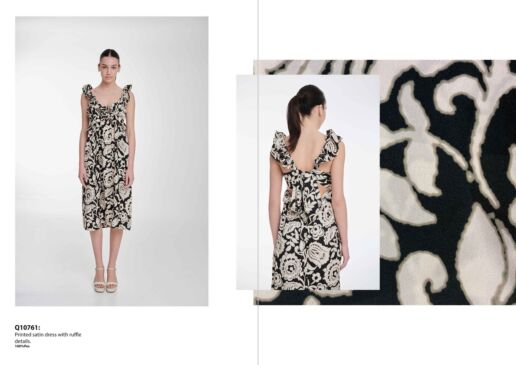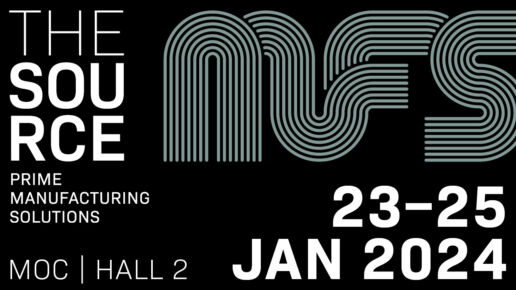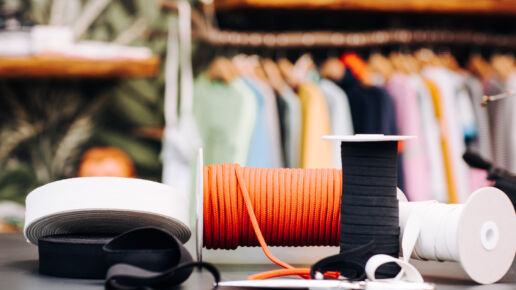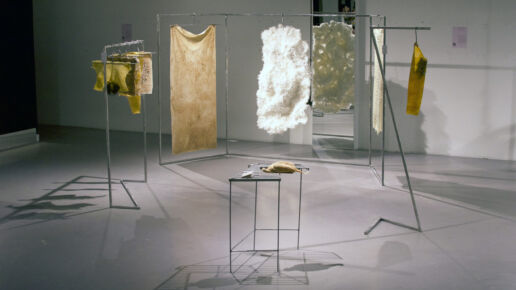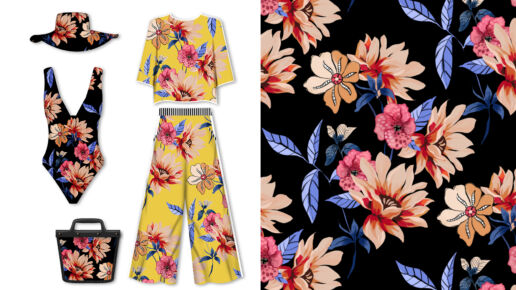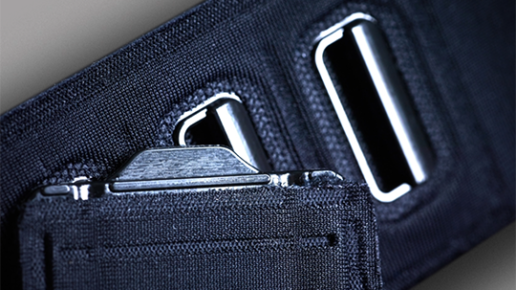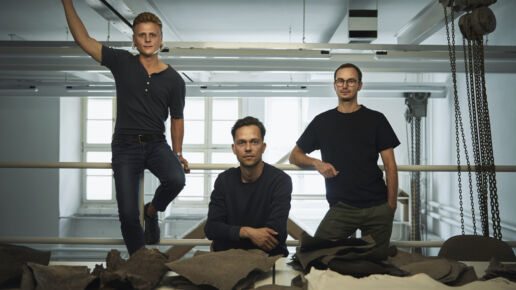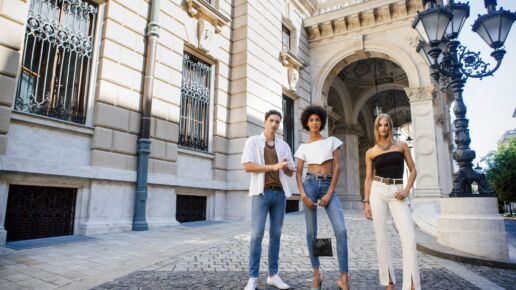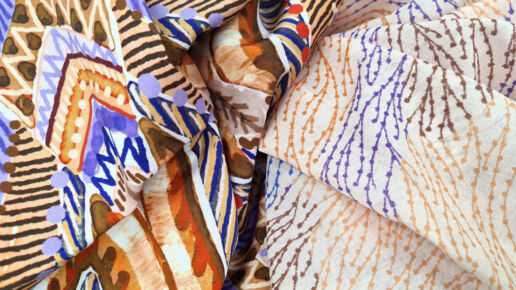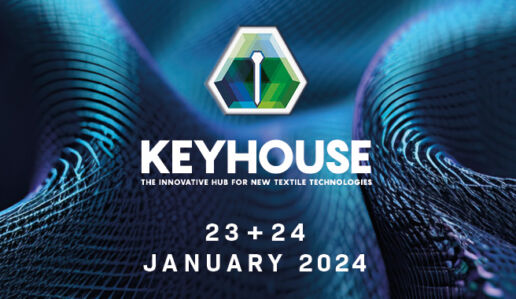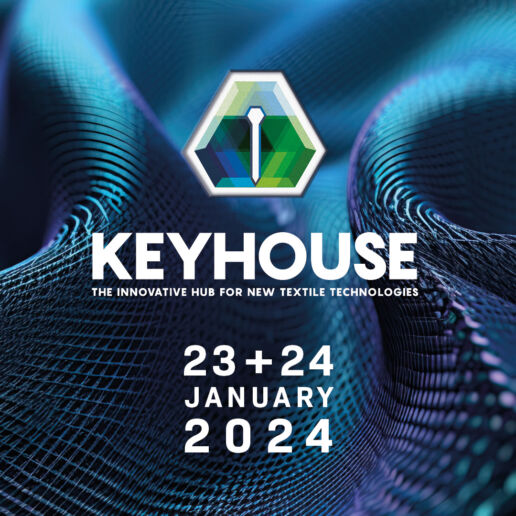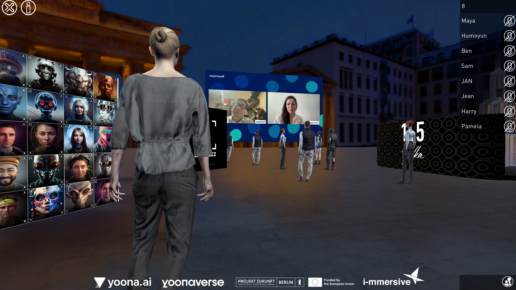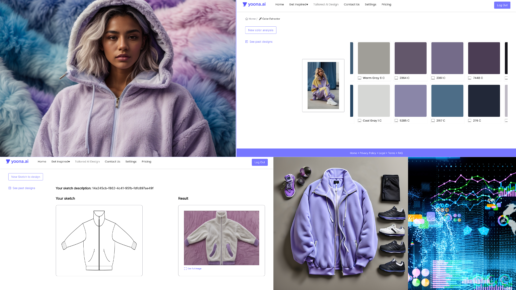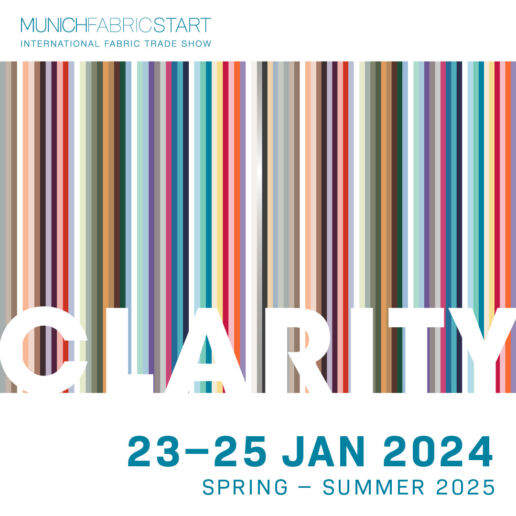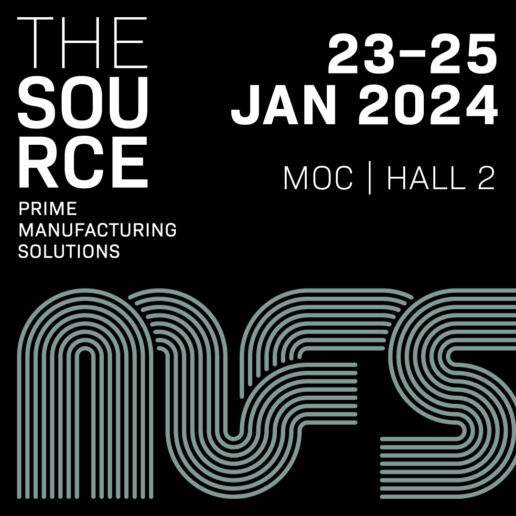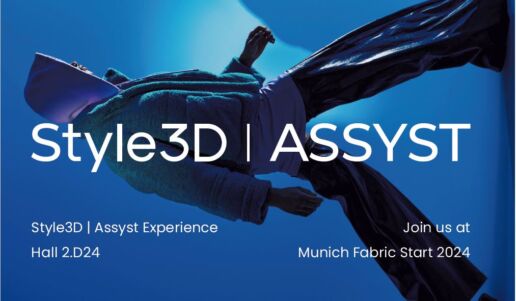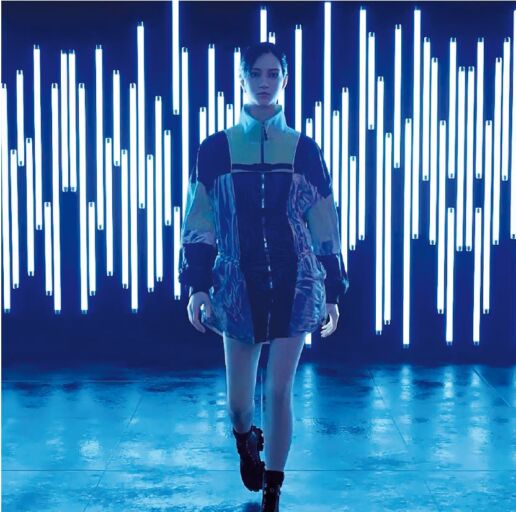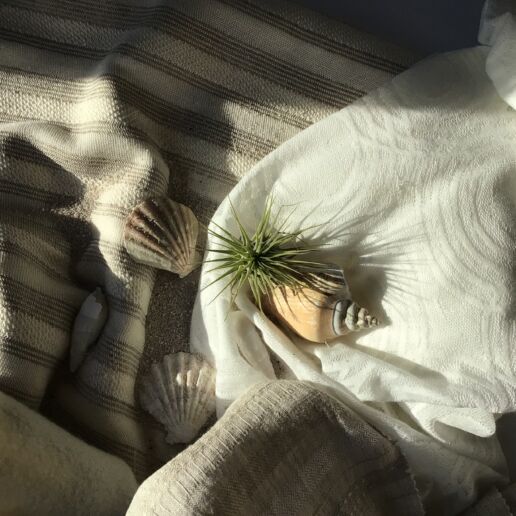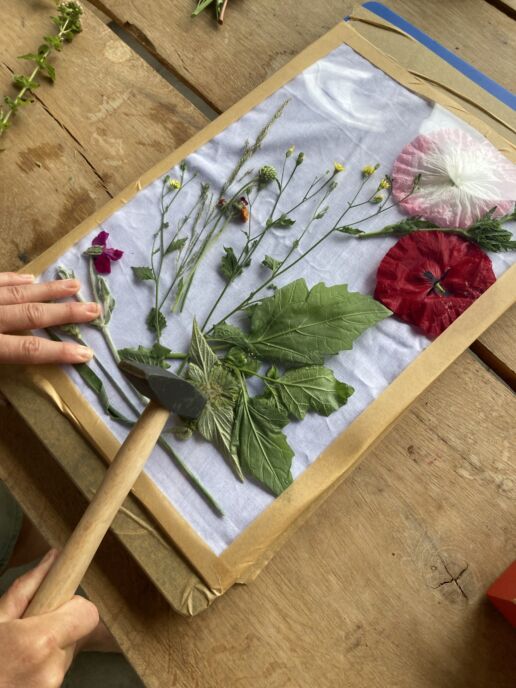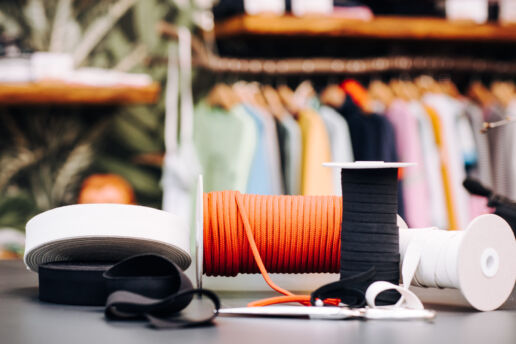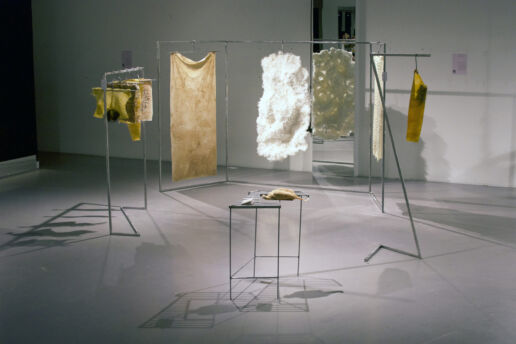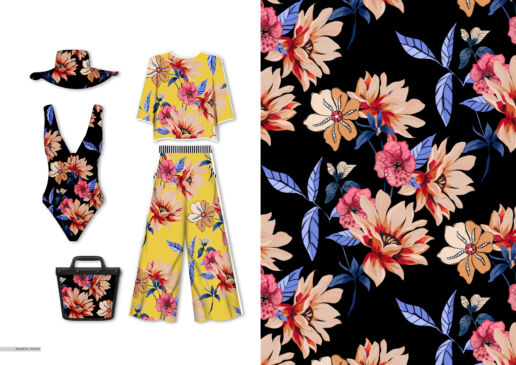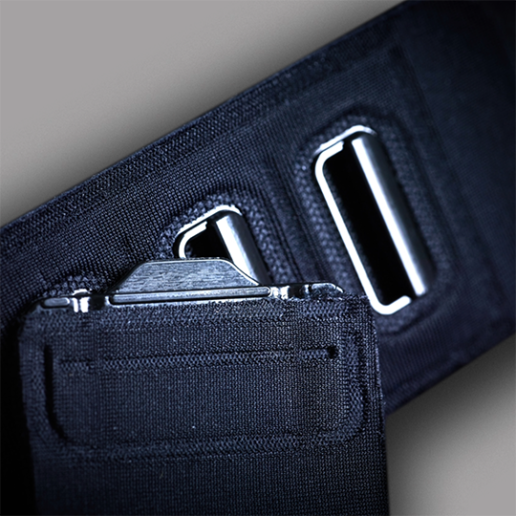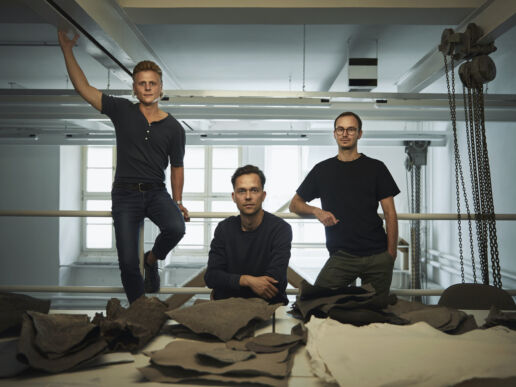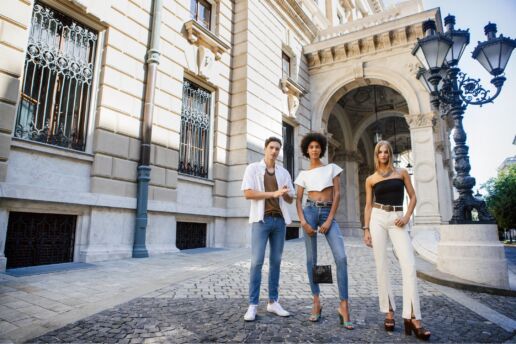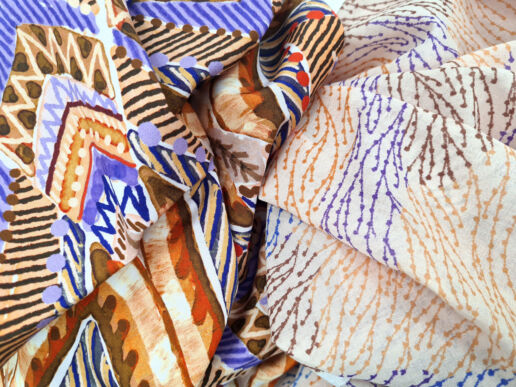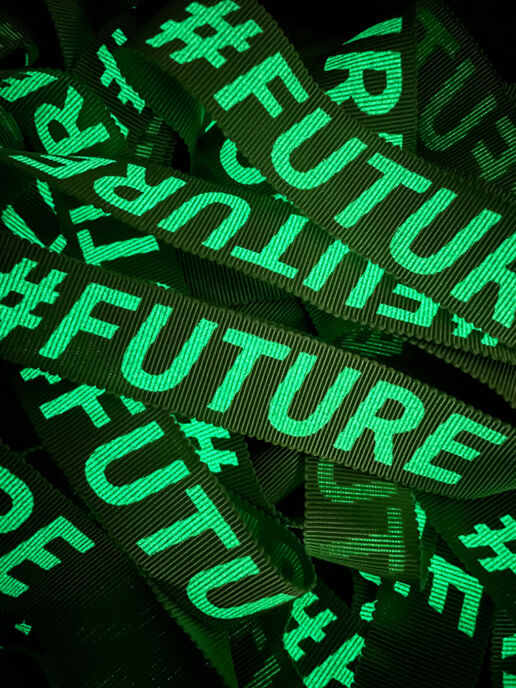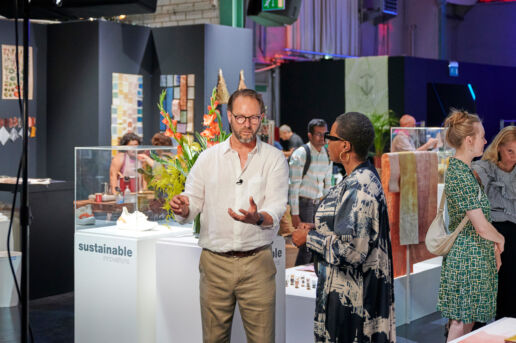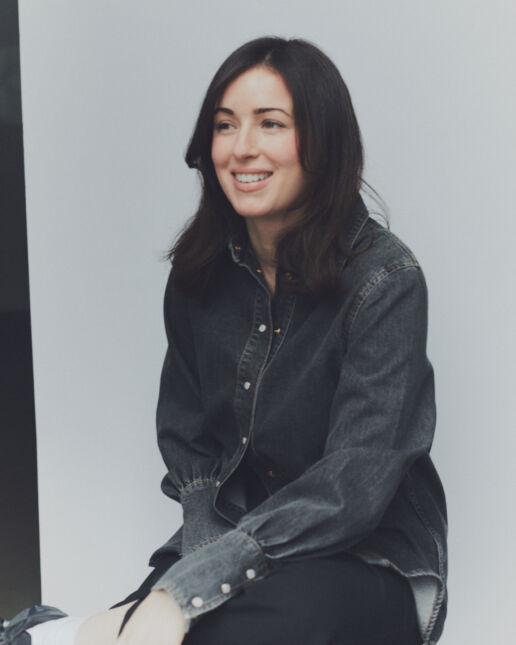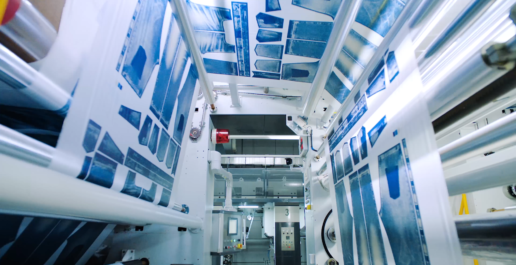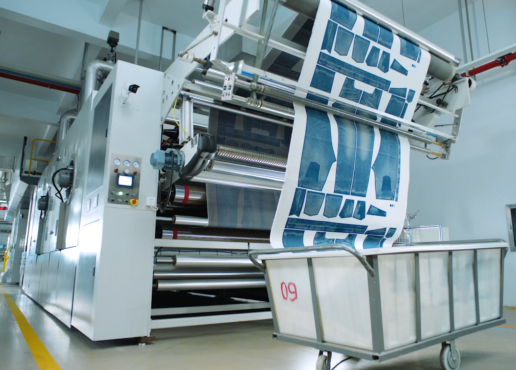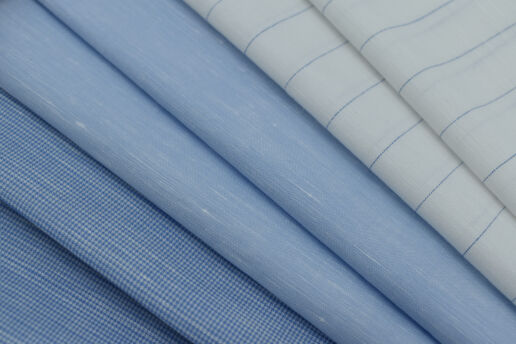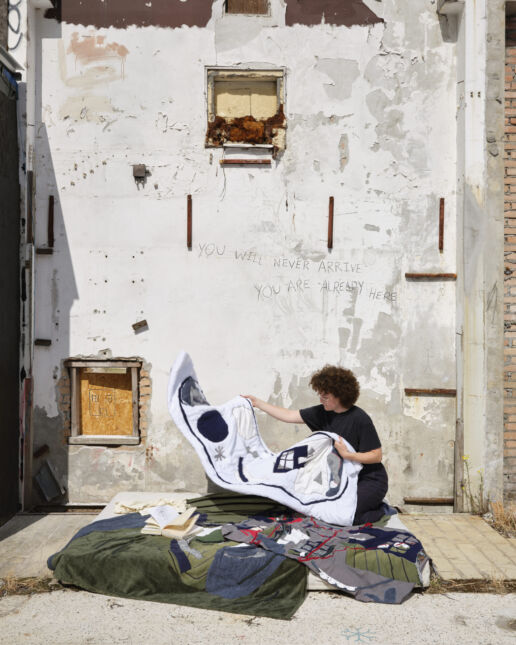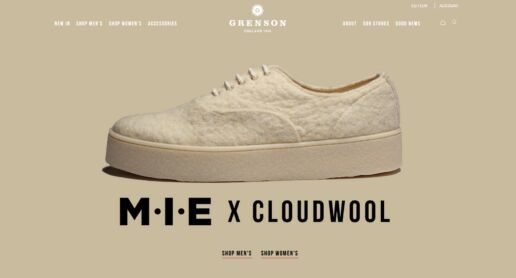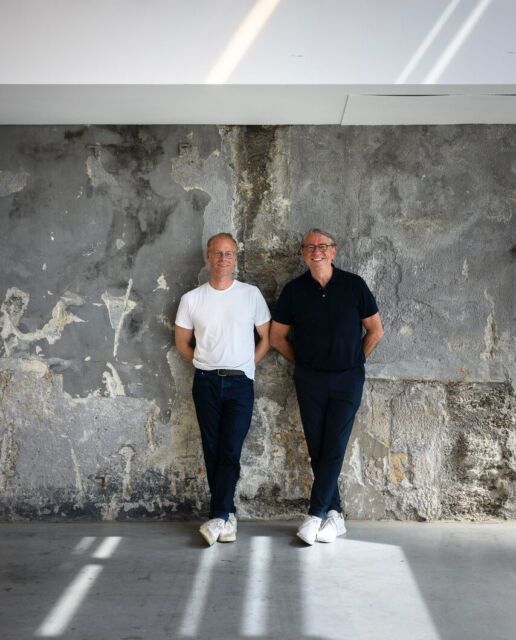Create Future
SAAT MUNICH X BLUEZONE
The BLUEZONE has chosen “SIGNATURE“ as this year‘s theme to emphasize the importance of a clear and unique vision in an ever-changing world.
The SAAT MUNICH Design Studio acts as a central link, drawing on its longstanding partnership to contribute expertise in sustainable conception, creation and production. The company excels in accurately capturing the latest trends and translating them into innovative and aesthetic designs. From high-quality denim products to customised corporate wear, SAAT MUNICH offers a broad range of stylish solutions that seamlessly combine functionality and elegance.
Together with three selected partners – CALIK Denim as a material expert, Le Faxx Jeans as a renowned denim manufacturer, and nat-2™ as an innovative and sustainable shoe partner – the SAAT MUNICH Design Studio aims to represent the theme “BE YOUNIQUE“ by designing the Bluezone hostess outfits.
Calik Denim‘s journey spans three decades, marked by passion for denim innovation and growth. From its roots in 1987 as Calik Holding‘s first investment, it has evolved into a global denim fabric leader, employing over 2,000 people and producing 55 million meters annually. The journey has been marked by milestones, including the establishment of an integrated plant and the development of a renowned R&D Center. Their commitment to sustainability drives them to create impactful, innovative fabrics, aiming to transform the industry and positively influence lives.
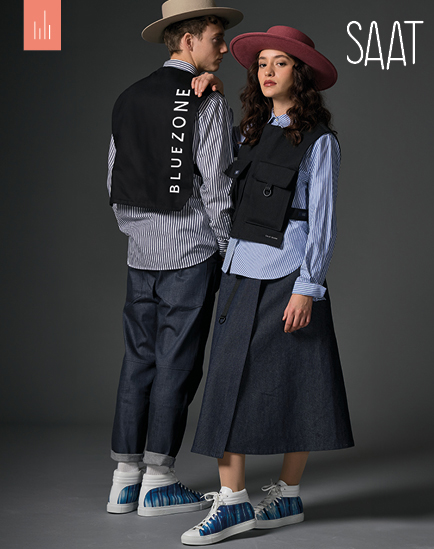
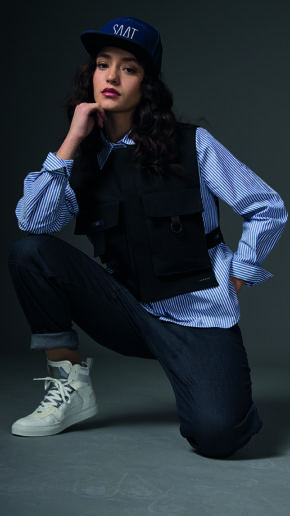
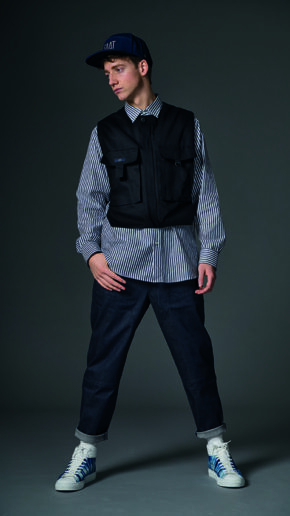
Le Faxx Jeans, founded in 2000 by Mr. Vedat Dogan and Mr. Ibrahim Önder has its headquarters in Istanbul and production facilities in Sivas. With 600+ staff and 25+ years‘ experience, it stands as a leading producer of denim and non-denim products. The company prioritizes cutting-edge production technology, social economic responsibility and operates a fully equipped in-house production facility.
Le Faxx Jeans prides itself on delivering premium, high-quality jeans through its use of advanced technology and a modern machine park. nat2™, founded in 2007, the 6th generation team around Carmen & Sebastian Thies has been designing and producing creative, sustainable shoes and accessories for international brands, retailers and corporates since 1856. The brand being the winner of various design awards, the focus is on innovation, aesthetics, special materials and production in Europe.
This partnership combines the core competencies of all four partners to create a unique denim look for the Bluezone hostesses.
The “SIGNATURE Corporate Collection” from SAAT – a pinnacle of elegance and sophistication. Crafted with great attention to detail and an unwavering commitment to excellence, the collection epitomises the grace of the company. From elegant stationery to eye-catching accessories, each item reflects refined style and unrivalled quality. Don’t miss the chance to discover this embodiment of sophistication and professional finesse.
Discover more industry-changing innovations at our upcoming trade fairs:
THE SOURCE 2024 - Spring.Summer 25 - Part I
Some 30 selected clothing manufacturers present their products and services around the latest sourcing services and apparel manufacturing at THE SOURCE studio in hall 2. The range of services of the internationally experienced manufacturing companies include cut-make-trim (CMT) solutions as well as high-end production. Furthermore, services such as A-Z process solutions including procurement processes are offered – a suitable addition to the diverse portfolio of MUNICH FABRIC START.
As part of the MUNICH FABRIC START, THE SOURCE is a one-stop sourcing platform and the stage to all-in-one providers to present turnkey, end-to-end solutions from PLV to white-label for brands, labels and retail.
Companies from some of the most important manufacturing countries such as Italy, Portugal, Greece or Turkey will be on site to present a business-relevant mix of services. Discover THE SOURCE in Hall 2.
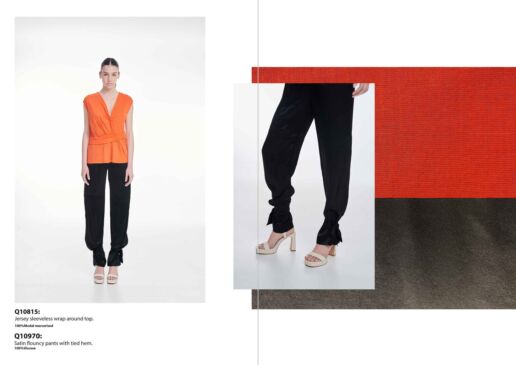
DMISS TEXTILE GROUP
At DMISS, the spring summer season plunges us into a desire for pleasure, abundance and a continuously search for well-being. We reconnect with our senses and emotions, new entry patterns in classic ideas reignite and are created authentically by updating know-how and craftsmanship while focusing on materials with a certain roughness but also smoothness. The connection with nature benefits from the input of technological innovations that can be adapted to climatic changes while preserving the development of natural materials.
EAST DK
Fashion is not only about following trends, but also about expressing your creativity and personality. That’s why we at www.EASTDK.com are proud to present our spring-summer collection of ladies apparel, featuring sustainable fabrics, vibrant colours and original designs. Whether you are looking for a casual outfit, a formal dress or other inspiring garments, you will find something that suits your style and values on their booth. Don’t miss this opportunity to refresh your collection with the updated collection for spring / summer 2025!
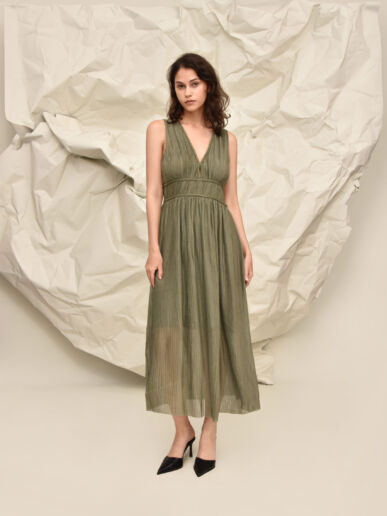

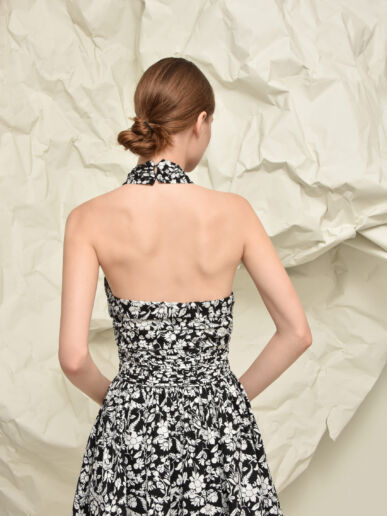
EKOLTEKS
Ekolteks Tekstil is a leading supplier of sustainable and organic knitted tops and bottoms for ladies-, mens-, kids- and babywear such as t-shirts, sweatshirts, tank tops, hoodies, jackets, pants, yogawear etc. Their core strength lies in offering high-quality products, also in small quantities, as well as quick delivery times. They offer both, OEM services and the development/design of collections for their customers.
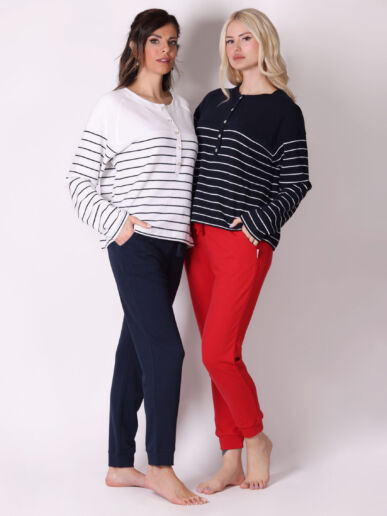
THIS MIGHT BE ALSO INTERESTING FOR YOU
Fabric Trends Spring.Summer 25 – Part IV
28. March 2024
Summer, sun, well-being: Cooling materials such as cotton, linen, hemp is wanted as plain or combined qualities.
Blooming Minds – Sustainable Innovations
26. March 2024
Elizabeth’s research focuses on combining nature – especially the use of natural and recycled materials – and community, a social practice which weaves themes such as mental health while encouraging accessible creativity.
The latest accessory developments for Spring.Summer 25 – Part II
21. March 2024
The narrow fabrics combine excellent elasticity with sustainable materials and promote environmentally friendly practices.
Being Plucked – Sustainable Innovations
19. March 2024
"Being Plucked" questions underlying assumptions and illuminates the political dimensions of decisions about one's body.
DESIGN STUDIOS – SPRING.SUMMER 25 I
14. March 2024
Their collection is inspired by the latest catwalks, Copenhagen street style and consumer trend reports.
Fabric Trends Spring.Summer 25 – Part III
12. March 2024
They are crafting high-end fabricsby embracing minimalism and precision and combine exceptional functionality with collective responsibility and prioritize the development of degradable materials with a minimal ecological footprint.
Revoltech – Sustainable Innovations
7. March 2024
The revolution of Revoltech lies in the use of Hemp-Leder, an advanced fusion of hemp fibers and traditional leather.
BLUEZONE Signature Spring.Summer 25 – Part I
5. March 2024
IBIZABLUE is a bright and vibrant shade inspired bythe summer season. This unique colour allows fora range of washes that maintain their vitality, evenafter multiple wash cycles.
Fabric Trends Spring.Summer 25 – Part II
27. February 2024
It's safe to say that a return to joy and lightness is in the air in the world of fashion!
The latest accessory developments for Spring.Summer 25 – Part I
22. February 2024
A big part of the collection consists of natural fibers with super light ribbons in 100% cotton, a linen braid-effect ribbon and hemp ribbons for a sustainable-oriented collection.
KEYHOUSE 2024 trends spring.summer25
In the atmospheric industrial charm of KEYHOUSE, Hall 5, progressive suppliers and global players from cross-industry sectors will be showcasing their latest new developments and innovations. On over 1,000 square metres, you will find trend-setting future fabrics and new process technologies – be it in terms of sustainability, circular economy, digitalisation & AI, traceability, textile dyeing or finishing. Staged as an interactive think tank, future-oriented show cases will be in the spotlight alongside sustainable innovations.
KEYHOUSE is also home to the main lecture forum of MUNICH FABRIC START with exclusive keynotes, panel discussions, trend presentations, Q&A sessions & expert talks by international industry insiders. Be inspired by the wide range of events at KEYHOUSE.
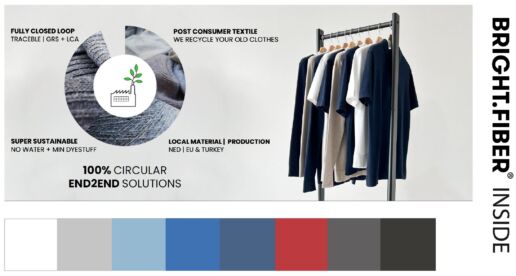
BRIGHTFIBRE
BRIGHT.FIBER® INSIDE: 100% circular – end2end – solution provider. We turn your old clothes into new textile. Brightfiber Textiles works in a fully closed loop and turns post consumer textile waste from the end consumer, into brand new collections. Brightfiber Textiles works with local waste streams and automatically sort, clean and process material into BRIGHT.FIBER’s in their circular factory in Amsterdam.100% circular stock yarns are produced in beautiful, contemporary and seasonal colors. BRIGHT.FIBER minimizes the use of virgin resources and offers circular and sustainable end2end solutions.
EEDEN
eeden enables the production of fibers such as Lyocell, Viscose, or Polyester from end-of-life textiles. They have developed a holistic upcycling technology to extract cellulose and polyester from discarded fabrics. Their process is in line with EU regulations, conserving resources and offering a scalable, circular solution to the waste challenges of the textile industry. Visit them at the KEYHOUSE and learn more about their upscale.

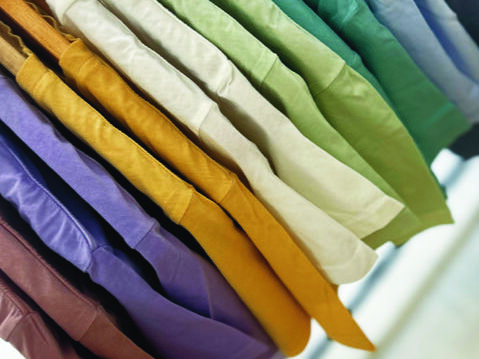
EYAND
EYAND presents a collection with a large range of natural colours, all with very good colour fastness. Certified with Oeko-tex and GOTS. Their natural dye cotton, wool, cashmere and silk garments and offer a full package service from the knitting of the fabric, Inhouse workshop for pattern making and proto samples and garment dyeing with their natural colours.
SOKO
Following its innovative nature, the Italy based chemical company Soko has recently launched the “Projects Division” which aims to become the research department open to collaborations – on a project basis – for all players in the textile industry. The Projects Division will evaluate, analyse and seek solutions for specific targets which will be rised from the corresponding partner or Soko itself. The work will range from the optimisation of the washing process, to new finishing techniques and any topic which may constitute a challenge or a discussion.
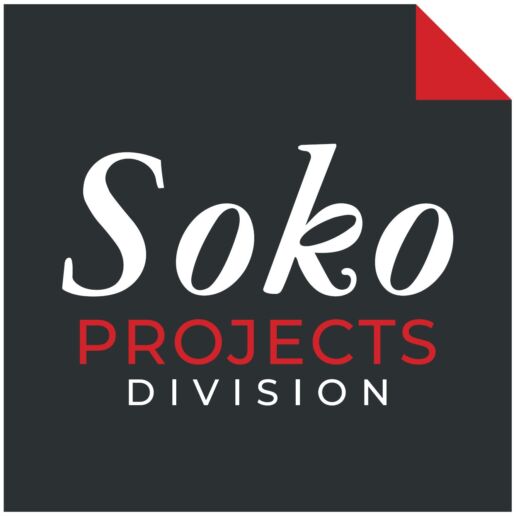
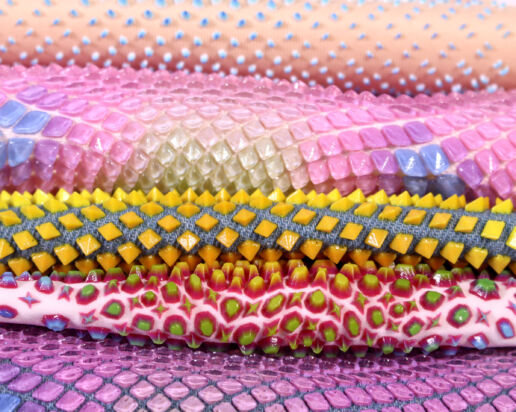
STRATASYS
Stratasys, a 3D printing solutions pioneer, introduces the first 3D printer designed for direct-to-textile printing: the J850™ TechStyle™. Powered by their 3DFashion™ technology, it is already revolutionizing prototyping and manufacturing in the fashion and automotive sectors, enabling unparalleled design complexity and customization. Their technology accelerates lead times, enhances design flexibility, and supports sustainable production, with more applications continually emerging.
WKS
COMBAT CLOTHING WASTE – WKS Group, an established textile solutions provider with 7 European locations, offers an extensive range of sustainable services throughout the fashion supply chain. These include quality assurance, reverse logistics, and personalized recovery strategies for damaged bulk productions. Introducing RE-VOGUE VENTURES, the circular initiative for the resale and refurbishment of second-hand garments involves the management of trade-ins professional renewal/ repair, and re-commerce of pre-loved clothing. This endeavour underscores WKS Group’s commitment to reducing clothing waste by transforming secondhand items into first-choice options, maximizing the lifespan of each garment.


YOONA.AI
yoona.ai Suite seamlessly merges Data Analytics and Generative AI, revolutionizing design as a collaborative interplay between human creativity and technological expertise. Every stroke, colour, and form is shaped by data-driven insights and empowered by AI-generated possibilities. This innovative synergy transforms design into a dynamic, strategic process, aligning aesthetics with market trends. Yoona AI Suite charts a course toward an evolved design landscape that captivates aesthetically while staying finely attuned to the pulse of the market – a fusion where human ingenuity dances alongside technological advancement, shaping a visionary future for design.
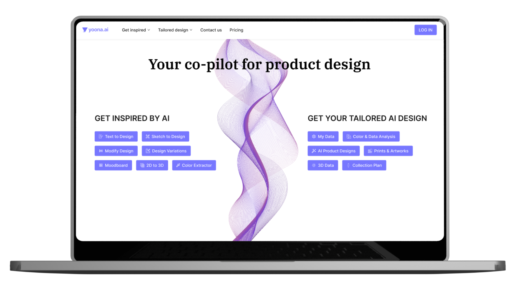
Das könnte Sie auch interessieren
Fabric Trends Spring.Summer 25 – Part IV
28. March 2024
Summer, sun, well-being: Cooling materials such as cotton, linen, hemp is wanted as plain or combined qualities.
Blooming Minds – Sustainable Innovations
26. March 2024
Elizabeth’s research focuses on combining nature – especially the use of natural and recycled materials – and community, a social practice which weaves themes such as mental health while encouraging accessible creativity.
The latest accessory developments for Spring.Summer 25 – Part II
21. March 2024
The narrow fabrics combine excellent elasticity with sustainable materials and promote environmentally friendly practices.
Being Plucked – Sustainable Innovations
19. March 2024
"Being Plucked" questions underlying assumptions and illuminates the political dimensions of decisions about one's body.
DESIGN STUDIOS – SPRING.SUMMER 25 I
14. March 2024
Their collection is inspired by the latest catwalks, Copenhagen street style and consumer trend reports.
Fabric Trends Spring.Summer 25 – Part III
12. March 2024
They are crafting high-end fabricsby embracing minimalism and precision and combine exceptional functionality with collective responsibility and prioritize the development of degradable materials with a minimal ecological footprint.
Revoltech – Sustainable Innovations
7. March 2024
The revolution of Revoltech lies in the use of Hemp-Leder, an advanced fusion of hemp fibers and traditional leather.
BLUEZONE Signature Spring.Summer 25 – Part I
5. March 2024
IBIZABLUE is a bright and vibrant shade inspired bythe summer season. This unique colour allows fora range of washes that maintain their vitality, evenafter multiple wash cycles.
Fabric Trends Spring.Summer 25 – Part II
27. February 2024
It's safe to say that a return to joy and lightness is in the air in the world of fashion!
The latest accessory developments for Spring.Summer 25 – Part I
22. February 2024
A big part of the collection consists of natural fibers with super light ribbons in 100% cotton, a linen braid-effect ribbon and hemp ribbons for a sustainable-oriented collection.
TIMELY TIMELESS
The new minimalism is more than a “palate cleanser” that is intended to give our senses a brief opportunity to recover before the next wave of opulent taste experiences hits them again. It’s sure to linger simply because it is linked to our worldview. In contrast to previous generations, for us “simple” no longer just means “simple and poignant”, but also “sustainable because timeless”.
Two seasons ago, the DMI FASHION DAY at MUNICH FABRIC START was about the question “Should we slow down or speed up?”. We had prepared you for the fact that the desire to slow down fashion would soon reach the mainstream. A recent survey confirms that fashion trends that change too quickly are viewed increasingly critically: three quarters of all women are of the opinion that there are too many and too extreme trends. 65% believe trends are becoming less and less important. And almost 94% pride themselves on saying that they buy regardless of trends.
Longevity is currently very popular. And that doesn’t just mean more solid quality, but also and above all a more timeless design. Fashion is responding to this growing demand for timeless design with increasingly understated design. In this respect, the new minimalism continues the by now century-old tradition of “less is more”, but in a completely new zeitgeist setting. A lot of what is wrongly labelled “Quiet Luxury” actually doesn’t want to look like old money, but rather just be timeless.
Paradoxically, it is currently trendy not to be trendy. People want clothes that look timeless. But then again, paradoxically, timelessness is not timeless either. So we are faced with the challenge of creating a look that is trend-independent in a trendy way and timeless in a contemporary way.

Carl Tillessen
“The debut last season was the best confirmation of our concept of providing trend information with the DMI FASHION DAY exactly when it is needed, namely at the moment when the course for the next season is set with the selection of fabrics. I’m really looking forward to meeting and exchanging ideas with everyone in Munich.”
Carl Tillessen, CEO DMI
INFORM & INSPIRE YOURSELF AT THE MUNICH FABRIC START AT DMI:
You can find out how you can make this work for you in a personal conversation with the DMI analysts. Feel free to contact us anytime.
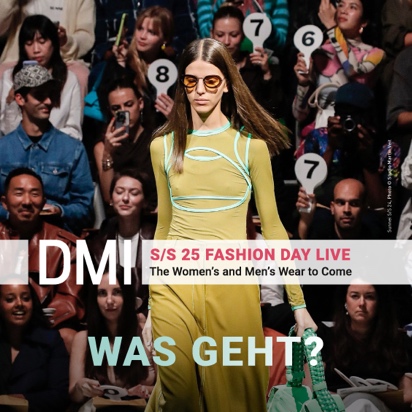
Discover more industry-changing innovations at our upcoming trade fairs:
Digitale Klarheit im Design - ASSYST
Digital processes elevate design to a new level, but only when the result is right and quick. To ensure the flow of ideas and data, Style3D | Assyst passionately develops and confidently explores new paths.
In the 3D simulation, the dress moves as if caught in a breeze. Whether it‘s a skirt or a down coat, the movement looks so realistic that one tends to forget the computer. Everyone in design, technical development, and pattern teams is meant to experience this seamless connection between the digital and the real world. Fabric, human, and pattern are realistically represented, pushing the boundaries of technology. The results are captivating, opening up new possibilities in clothing development and fabric design.
Digital fabrics facilitate collaboration
With both physical and digital fabric versions, manufacturers can provide better guidance. At events or in their own showroom, fabrics are collectively examined. The scanned digital version can be recolored, enlarged, experimented with in designs, and shared with colleagues on-site or later in the company. Once everyone agrees, the fabric is purchased and ideally produced afterward.
3D design and 2D patterns merge
A common scenario: everything looks good digitally until the pattern comes into play. Suddenly, a seam line on the back or inserts on the sleeves are necessary, disrupting the design idea. Numerous approval rounds like these are required in developing a new collection. It‘s much faster when the design interacts directly with the production-ready pattern. The designer doesn‘t need to switch to the CAD system; the pattern stays in the background, automatically updating and reapproving for significant changes.
3D clothing reaches customers
From showroom to eShop or store, it can take weeks … or just days. With the right tools, 3D designs transform into high-quality marketing and sales visualizations. All with the characteristics of the digital product matching the real one, complemented by suitable digital experiences.
Artificial Intelligence begins to create value
When rapid new ideas are needed, inspiration is crucial. AI, like in a brainstorming session, helps generate fresh ideas and refine one‘s concept. Designs can be created quickly, and unsuitable versions can be sorted out promptly. The right design can be replicated and further refined.
Fashion undergoes sustainable change
When design (3D) and production (2D) seamlessly connect, the apparel industry changes significantly. Design, pattern, and technical development can work more easily, sustainably, and cost-effectively, resulting in less fabric and fewer patterns throughout the process. The remarkable aspect is that this revolution requires minimal effort for individuals. Everyone can continue working in their familiar systems, and the integration of systems leads to a closer collaboration with clear results. Each digital design matches the real product, providing extra clarity that is particularly valuable for design teams, thanks to the benefits of digitization.
WE LOOK FORWARD TO WELCOMING YOU IN
→ HALL 2 | D 24 or digitally at www.assyst.de
PROGRAM:
AI for inspiration and promotion
Digital Knitwear Design with KM.On
3D/2D.Connect – Design with product-ready pattern
Digital Fabric for brands and manufacturers
Collaboration – on site, remote or worldwide
OUR PRESENTATIONS IN THE KEYHOUSE:
Design from idea to shelf – the new possibilities for designers
with AI and 3D/2D.Connect from Style3D | Assyst
Global design & production – 3D/2D CAD in the supply chain
[Best Practice]
Discover more industry-changing innovations at our upcoming trade fairs:
ORTA x Long John
ORTA x Long John Presents: The biggest sustainable jeans!
The well-known Turkish denim manufacturer ORTA, celebrated its 70th anniversary last year teams up with Wouter Munnichs, founder of online denim magazine Long John and freelance denim specialist for brands and retail, to create the biggest sustainable pair of blue jeans ever made. This huge collaboration jeans will be on display at denim fabric trade show Bluezone in Munich, Germany on the 23rd and 24th of January, 2024.
This January, ORTA and Long John will join forces in a very special jeans collaboration. Together they developed the biggest sustainable jeans ever produced to set a new milestone within the denim industry. This display jeans is made with a waist size 133 and a total length of around 4,5 meters. For the inspiration of this collaboration jeans, they looked at the past when huge display jeans were made as a promotion for a denim brand. These originals were used to showcase a jeans brand in a unique and unmissable way in front of retailers and at rodeo events in the West of America from the 1920’s onwards.
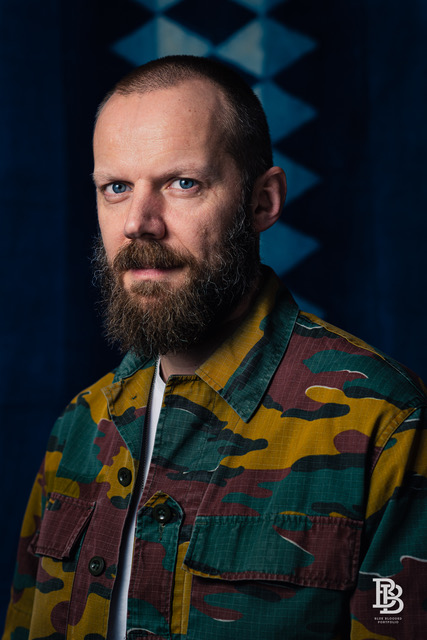
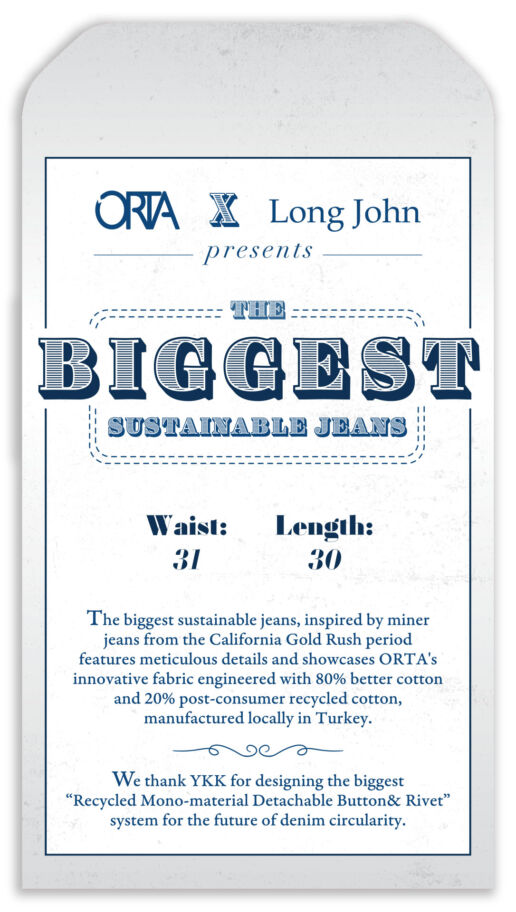
Showcasing the new sustainable denim fabric
The idea of making something that stands out came when ORTA developed a new sustainable denim fabric with code 4853A, colored Steel Blue. This rigid 2/1 Z twill denim fabric weighs 10.6 oz and is made with a composition of 80% better cotton + 20% post-consumer recycled cotton. The fibers as well as the fabric were all manufactured in Turkey locally. As a long partner of ORTA, Long John sat down with the ORTA to think about a way they could present this innovative denim fabric that can’t be missed by each visitor of the Bluezone trade show in Munich. Soon, they were thinking of creating this enormous pair of jeans.
The inspiration for the display jeans
The design of the ORTA x Long John display jeans is inspired on the original miner jeans that were worn during the kick-off of the so-called ‘Gold Rush’ period around 1850 in California, USA. During this period, many people from all over the world came to California when gold was discovered in the mines. To get the job done, a sturdy and durable pair of blue jeans was needed. This is seen by many as the kick-off of the history of denim. The rest is history.
The ORTA x Long John display jeans is produced with an eye for detail, just like the originals. Key detail features on this pair are included such as one back pocket, a cinch back, suspender buttons on the waistband, and even a crotch rivet on the front. Also, for this display pair, a huge hangtag is produced, the same as a back patch from sustainable cotton fabric showing both ORTA and Long John logos.
Displayed at Bluezone
The biggest sustainable jeans ever produced by ORTA x Long John will be showcased for the very first time at the denim fabric trade show Bluezone in Munich on the 23rd and 24th of January. Don’t miss this chance to get yourself photographed in front of this big 133-sized pair of blue jeans.
This might be also interesting for you:
Fabric Trends Spring.Summer 25 – Part IV
28. March 2024
Summer, sun, well-being: Cooling materials such as cotton, linen, hemp is wanted as plain or combined qualities.
Blooming Minds – Sustainable Innovations
26. March 2024
Elizabeth’s research focuses on combining nature – especially the use of natural and recycled materials – and community, a social practice which weaves themes such as mental health while encouraging accessible creativity.
The latest accessory developments for Spring.Summer 25 – Part II
21. March 2024
The narrow fabrics combine excellent elasticity with sustainable materials and promote environmentally friendly practices.
Being Plucked – Sustainable Innovations
19. March 2024
"Being Plucked" questions underlying assumptions and illuminates the political dimensions of decisions about one's body.
DESIGN STUDIOS – SPRING.SUMMER 25 I
14. March 2024
Their collection is inspired by the latest catwalks, Copenhagen street style and consumer trend reports.
Fabric Trends Spring.Summer 25 – Part III
12. March 2024
They are crafting high-end fabricsby embracing minimalism and precision and combine exceptional functionality with collective responsibility and prioritize the development of degradable materials with a minimal ecological footprint.
Revoltech – Sustainable Innovations
7. March 2024
The revolution of Revoltech lies in the use of Hemp-Leder, an advanced fusion of hemp fibers and traditional leather.
BLUEZONE Signature Spring.Summer 25 – Part I
5. March 2024
IBIZABLUE is a bright and vibrant shade inspired bythe summer season. This unique colour allows fora range of washes that maintain their vitality, evenafter multiple wash cycles.
Fabric Trends Spring.Summer 25 – Part II
27. February 2024
It's safe to say that a return to joy and lightness is in the air in the world of fashion!
The latest accessory developments for Spring.Summer 25 – Part I
22. February 2024
A big part of the collection consists of natural fibers with super light ribbons in 100% cotton, a linen braid-effect ribbon and hemp ribbons for a sustainable-oriented collection.
Diversity in Dynamics
Marvelling at the levels of sophistication and innovation modern fabrics have attained and continue to breach, it is easy to forget that our relationship with textiles is one of the most intimate and primal ones we have. Granted, today’s creations are (thankfully) far removed from the scratchy cloth our ancestors wore huddled around the fire.
But over the course of time, our relationship with textiles has changed. While we have – technically and commercially – never been closer to textiles, ambitiously engineering fabric compositions to cater to an increased demand of sustainability, for instance, we are ironically also stepping further away emotionally from what was once – literally – closest to us. Today, our engagement with textiles is largely dependent on the prism through which we choose to experience and value it:
We have increasingly come to approach textiles as objects of research and science, questioning what characteristics new fabrics ought to have and how existing textiles can be improved to comply with the ever-changing demands of the market. Impressive examples of such science-led approaches are two projects within the BIOTEXFUTURE-cluster, led by the Institute for Textile Technology (ITA) and the Chair for Technology and Organizational Sociology (STO) at RWTH Aachen together with their industry partner adidas. Within BIOTEXFUTURE, they investigate the transition of the textile value chain to bio-based materials, including alternatives to conventional elastane (CO₂Tex), or the establishment of bio-based polymers in the industry (BIOBASE).
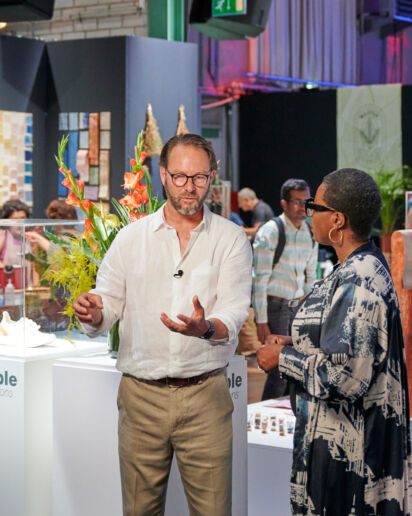
Of course, textiles also lend themselves to in-depth material exploration, analysing intricacies of production and means of (p)rethinking and challenging standards. Think of leather and its unique characteristics – who would have thought something strikingly similar could be crafted from a hemp plant, as illustrated by Lucas Fuhrmann’s “Revoltech”? Or going so far as to almost brutally decontextualize a biomaterial like feathers from their original purpose of insulation, submitting it completely to the functionality of aesthetics, as Suzanne Corcessin has done with “Being Plucked”.
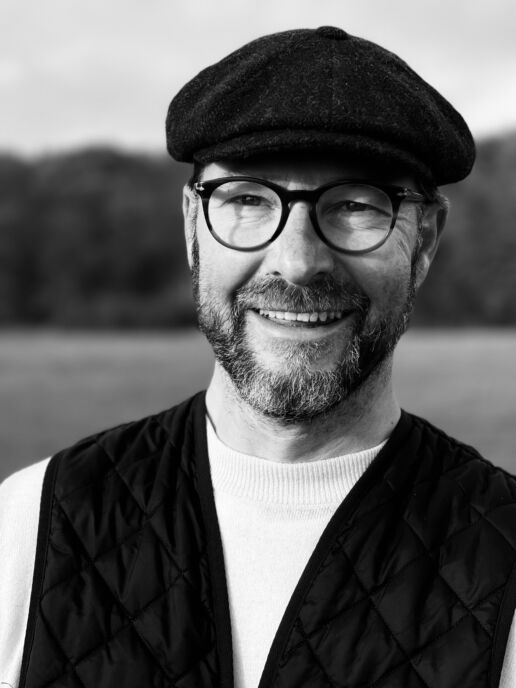
Simon Angel
And still, textiles can be a means of social connection – looking at the emotional component of fabrics, their functionality and the effects they have on others in public and private interaction, reconstructing relationships and the marriage between human and textile. Beautiful testaments of such exploration are the works of Paul Schaffer, whose collection of woven fabrics aims to foster appreciation for the interconnectedness of organisms, Sophie Conroy, who investigates the metaphysical significance of textiles as a connection between the body and the environment, and Elizabeth Balado’s “Blooming Minds: Social Printing”.
Are we leading or following completely different dynamics? Are we at risk of sacrificing artistic intimacy for scientific progress? Are we winning or losing touch? It’s not about being right or wrong, but a question of prism. The Sustainable Innovations Forum proves that it is possible to navigate these different dynamics. Take Cloudwool, for example: with a diverse portfolio and numerous opportunities to work with their product, they have attracted the attention of the likes of Grenson and Balenciaga, effectively demonstrating that it IS possible to unite the different dimensions of soul and science, while successfully positioning their product at the same time.
Feel the difference in dynamics for yourself – come and meet us in the KEYHOUSE and experience the Sustainable Innovations Forum.
Best wishes,
Simon
INFORM & INSPIRE YOURSELF AT THE MUNICH FABRIC START
IN THE SUSTAINABLE INNOVATIONS AREA IN THE KEYHOUSE – H5!
Discover more industry-changing innovations at our upcoming trade fairs:
GANNI – Fashion made from next-gen materials
Munique magazine contributor Muchaneta ten Napel, recently had the opportunity to sit down with Lauren Bartley, the Chief Sustainability Officer at GANNI to dive into the brand’s sustainable initiatives and vision for the future of fashion.
Muchaneta ten Napel (MTN): “Lauren, can you share with us GANNI’s journey towards sustainability and how it’s integrated into your brand’s ethos and fashion design?”
Lauren Bartley (LB): “Absolutely, Muchaneta. It starts with our founders Ditte and Nicolaj, who are personally passionate about the topic of sustainability and hacking the fashion system – it’s at the core of everything we do at GANNI and has been key to our progress in the area. In 2019, we created our first sustainability strategy the GANNI Game-plan comprised of 44+ goals to reach by 2023 surrounding People, Planet, Product and Prosperity. In 2022, we completed our first strategy and became a B Corp Certified company and now we are well in to our second strategy Game-plan 2.0, running until 2025 – which creates further impact to our business model and operations.”
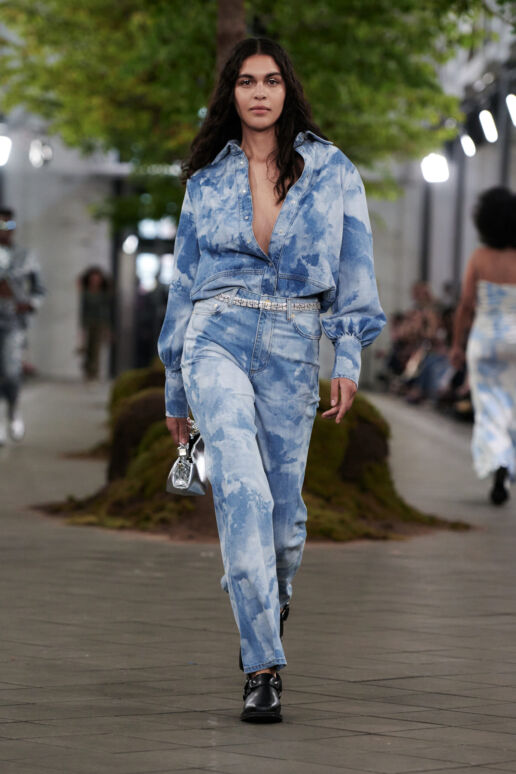
Future Denim Shirt med in Circulose® by Renewcell – a natural material made via textile waste, and Circulose®, which transforms textile waste into a new material without the need for cotton fields, oil, or trees
Our GANNI Bou bag in Ohoskin, made from orange and catus 100% Ohoskin (48% plant-based content, 52% Recycled Plastics)
Photo by Mathias Nordgreen
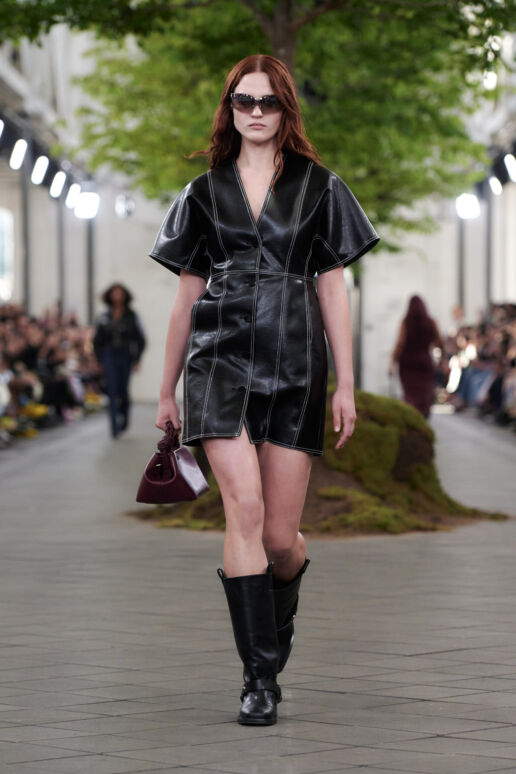
Dress in Oleatex – a plant-based olive leather alternative made from waste streams from olive oil production.
Our GANNI Bou bag in Ohoskin, made from orange and catus 100% Ohoskin (48% plant-based content, 52% Recycled Plastics)
Photo by Mathias Nordgreen
M.T.N.: “What are the unique challenges and opportunities you’ve encountered in incorporating next-generation materials into GANNI’s collections?”
L.B.: “The opportunity is to re-think fashion as we know it and empower our designers to do what they do best – get creative – and create something beautiful. We’re committed to working with fabric innovation as it’s the only way we will reach our ambitious carbon reduction goals – a 50% absolute carbon reduction by 2027. By 2025, 10% of our collections will be made from Fabrics of the Future. There are obviously challenges too, especially around scalability and the commerciality of the materials and that’s why it’s so important for us to invest and encourage other brands to invest too, because we all desperately need the solutions the innovators are offering. Commercial viability, but it’s essential to invest in these innovations.”
M.T.N.: “How has GANNI’s experience been in piloting new textiles on a smaller scale, and what impact has community feedback had on these initiatives?”
L.B.: “We will always introduce a new fabric innovation through a pilot project, to test and learn and get feedback from our community. So far, the response has been extremely positive. For us it’s about seeing these next-gen materials as something new and not comparing it to existing materials and fabrications.”
M.T.N.: “Navigating the costs and investments in sustainable materials is crucial. Can you discuss GANNI’s approach?”
L.B.: “Its early days, for now we have piloted around 10 material innovations, but the challenge is really to scale them to a commercially viable status. The pilots are an investment for GANNI, with no clear return on investment, that is not a sustainable model for any company and that is why we need these innovators to succeed and for GANNI to do whatever we can to help make it possible. We will have Renewcell’s Circulose in our main collections in 2024 and scaled and it’s exciting to see how that resonates with our community.”
M.T.N.: “Could you share insights into GANNI’s strategies for circular fashion and waste management?”
L.B.: “As part of our Game-plan 2.0 and commitment to Circularity, we have a goal of 5% of revenue coming from circular business models by 2025 from a 2021 baseline. With our Circular Business Models we look at new business models that have potential to reimagine the fashion industry as we know it. Currently, we are revising the Circularity strategy and will be sharing more on our goals within the pillars ‘Designed for Circularity’, ‘Recycling’ and ‘Circular Business Models’ in early 2024.”
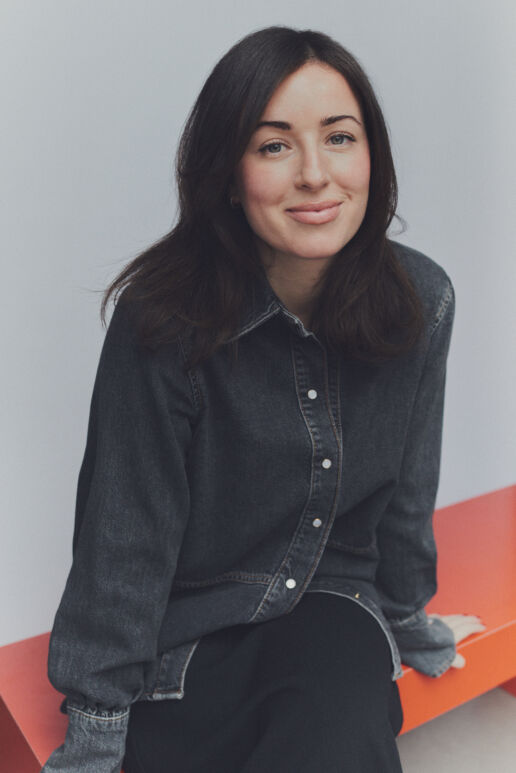
M.T.N.: “How does GANNI approach consumer education regarding sustainable fashion?”
L.B.: “Our biggest communication channel on Responsibility is our instagram account @GANNI.Lab where 100% of the feed is dedicated to our journey in becoming the most responsible version of ourselves. This is very much about what GANNI needs to do and where we are on our journey and does not put the onus on the end consumer. With all our communication we try to speak to our community in a meaningful and honest, not perfect way, showing the hard stuff, the stuff we didn’t get right, as much as we show the stuff we nailed.”
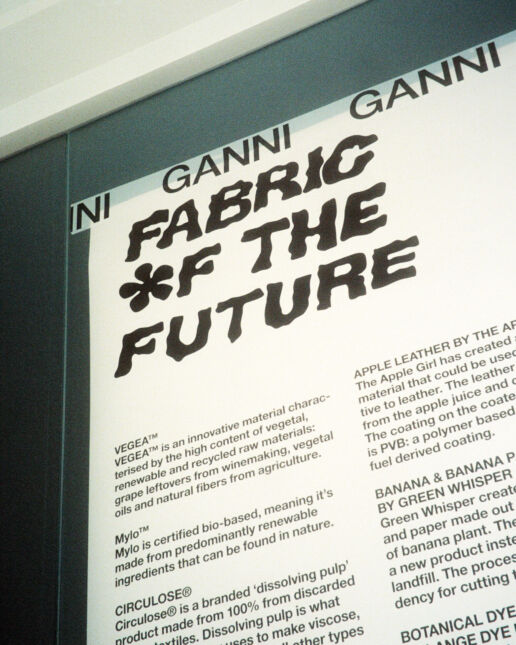
M.T.N.: “In the context of forming partnerships, what insights can you share about GANNI’s collaborations?”
L.B.: “We believe in the power of industry collaboration, no brand will succeed in a sustainable transition alone. GANNI works with over 30 material innovators and 13 partners and software solutions to help us progress on environmental sustainability, social sustainability and traceability. We would not be where we are without our partners.”
M.T.N.: “As the Chief Sustainability Officer, what is your vision for the future of sustainable fashion?”
L.B.: “For me, the onus is on the brands to offer more sustainable solutions to its customers – whether that be more responsible fabrics, transparent supply chains, workers paid a living wage and the adoption of new business models such as resale. We cannot force people into sustainable fashion, but by making it convenient, accessible and raising the education and awareness of some of the challenges and ultimately solutions in the industry, we can encourage more responsible consumption and behaviour. It’s a brave endeavour for a brand to recognise their own shortcomings, but being transparent, being honest and not perfect solidifies the value and integrity of the company- which ultimately, we can all appreciate as consumers”.
Are you interested in more in-depth facts and figures on the new textile industry?
Visit the Shape Innovate Lounge in H5 | 04 or take part in the mini-lectures in the Keyhouse.
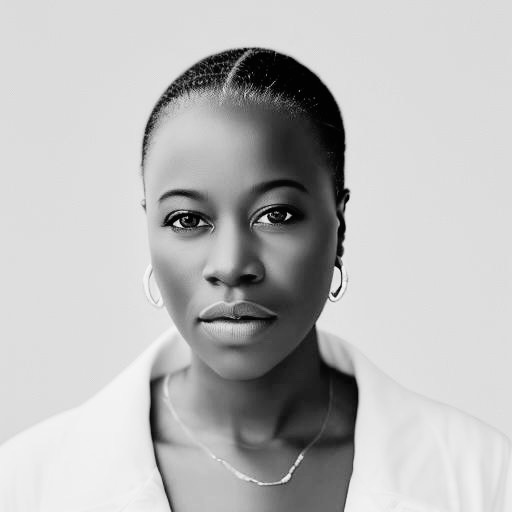
About the author
Muchaneta Ten Napel is the founder of Shape Innovate, a company that critically examines the economic impact of the fashion industry and publishes comprehensive, data-driven research, white papers and forecasts that shed light on the fiscal dynamics of both fast fashion and sustainable fashion practices.
In addition to running Shape Innovate, Muchaneta is the driving force behind FashNerd.com, her own digital platform dedicated to the latest tech developments in the fashion industry. As well as writing for her platform, she has also contributed to Vogue Business and is currently a senior contributor at The Interline.
Muchaneta is a lecturer at London College of Fashion (UAL), has taught at Conde Nast College of Fashion and UCL and has held a workshop at Zurich University of the Arts to share her extensive knowledge.
With extensive industry experience, Muchaneta is also a fashion innovation consultant and has authored in-depth research for companies such as LVMH Atelier.Muchaneta, who was actively involved with the UNFCC and Climate KIC during COP27, is now Chair of the Cultural and Creative Industries (CCI) Taskforce for the UN Climate Change Global Innovation Hub.
To further expand her influence, Muchaneta hosted the Innovation Stage at the Global Fashion Summit in Copenhagen and is a board member of the Fashion Innovation Center, where she contributes her strategic insights to further revolutionise the industry.
Muchaneta ten Napel | m@shapeinnovate.com
This might be also interesting for you:
Fabric Trends Spring.Summer 25 – Part IV
28. March 2024
Summer, sun, well-being: Cooling materials such as cotton, linen, hemp is wanted as plain or combined qualities.
Blooming Minds – Sustainable Innovations
26. March 2024
Elizabeth’s research focuses on combining nature – especially the use of natural and recycled materials – and community, a social practice which weaves themes such as mental health while encouraging accessible creativity.
The latest accessory developments for Spring.Summer 25 – Part II
21. March 2024
The narrow fabrics combine excellent elasticity with sustainable materials and promote environmentally friendly practices.
Being Plucked – Sustainable Innovations
19. March 2024
"Being Plucked" questions underlying assumptions and illuminates the political dimensions of decisions about one's body.
DESIGN STUDIOS – SPRING.SUMMER 25 I
14. March 2024
Their collection is inspired by the latest catwalks, Copenhagen street style and consumer trend reports.
Fabric Trends Spring.Summer 25 – Part III
12. March 2024
They are crafting high-end fabricsby embracing minimalism and precision and combine exceptional functionality with collective responsibility and prioritize the development of degradable materials with a minimal ecological footprint.
Revoltech – Sustainable Innovations
7. March 2024
The revolution of Revoltech lies in the use of Hemp-Leder, an advanced fusion of hemp fibers and traditional leather.
BLUEZONE Signature Spring.Summer 25 – Part I
5. March 2024
IBIZABLUE is a bright and vibrant shade inspired bythe summer season. This unique colour allows fora range of washes that maintain their vitality, evenafter multiple wash cycles.
Fabric Trends Spring.Summer 25 – Part II
27. February 2024
It's safe to say that a return to joy and lightness is in the air in the world of fashion!
The latest accessory developments for Spring.Summer 25 – Part I
22. February 2024
A big part of the collection consists of natural fibers with super light ribbons in 100% cotton, a linen braid-effect ribbon and hemp ribbons for a sustainable-oriented collection.
STELLA BLU PRESENTS ITS FIRST COOLTRANS DENIM COLLECTION MADE WITHOUT INDIGO
Stella Blu is very proud to announce to be the first Denim mill in the world to adopt the use of NTX Cooltrans – the revolutionary waterless coloration technology into its production of denim & colored denim fabrics.
The coloration process happens with extreme precision and consistency every time and is applicable to almost any fabrics, natural, cellulose-based or synthetics man-made without the need for heat and over 90% reduction in water usage without compromising the fabric’s engineered feel or functional performance.
Conventional denim has an extensive use of water, heat and chemicals starting from the initial processes of fabric making – dyeing yarns into several indigo baths – all the way down to laundry processes to create that vintage distressed look.
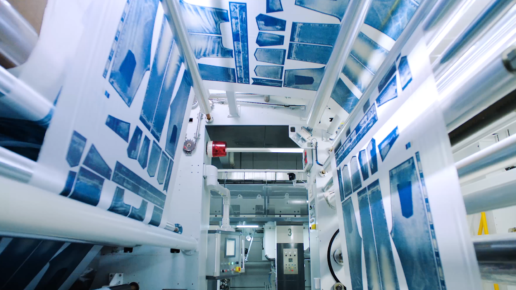
“With Cooltrans, we are able to completely eliminate these two processes.”, says Marco Stefanelli, director of marketing & business development at Stella Blu. “We start from a white PFD fabric and then the coloration process happens without heat at both sides simultaneously in only one single pass—the front face gets the printed washed look and the back side face gets printed with the twill line or any other pattern the client’s desire.”
This technology opens up extremely exciting possibilities. For instance, clients could have a single quality greige and print nearly infinite combination of aesthetics. By doing so, they can drastically improve the speed to market with much lower SKUs.
Many denim brands today maintain extensive material libraries, consisting of well over 500 different types of fabric, solely for the purpose of achieving a desired look. However, with Cooltrans, the aesthetic can be completely independent of the fabric composition. By calibrating the process to a specific fabric base, brands can achieve a wide range of aesthetics on a single twill type, resulting in tremendous costs savings.
Furthermore, addressing the environmental impact of indigo dye is a shared concern within the industry. Cooltrans is seen as a promising solution to reduce the toxicity associated with indigo dye as there is no indigo involved in the entire process, which is an additional key point that many brand houses view it favourably.
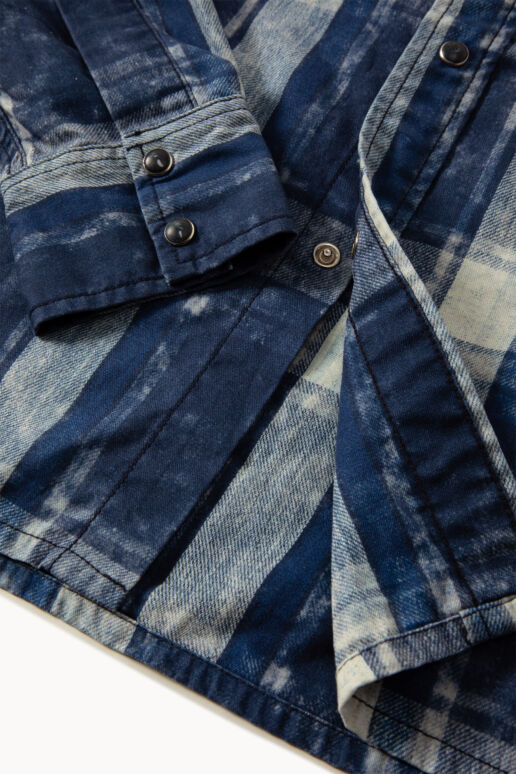
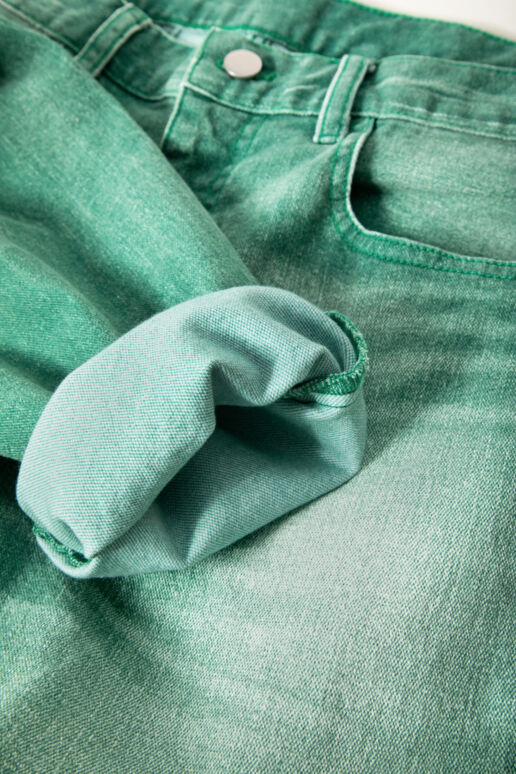
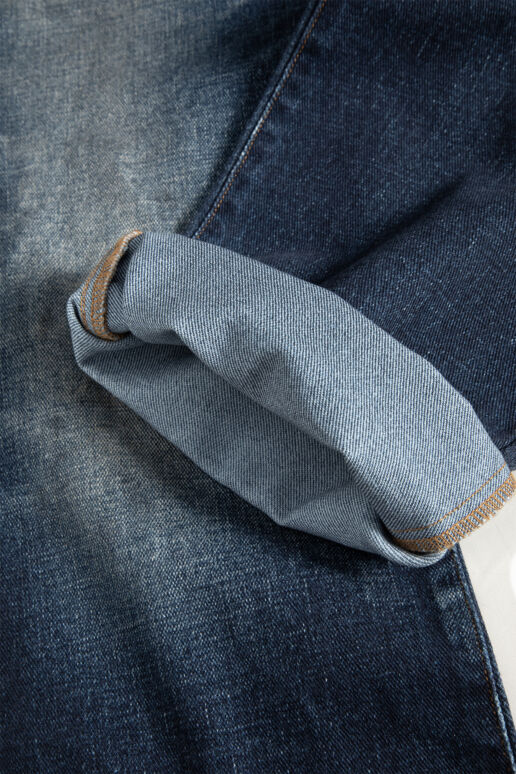
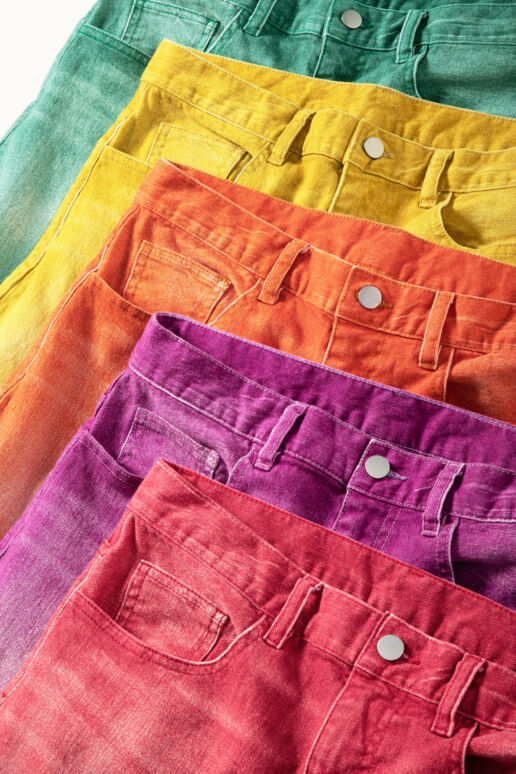
Meet the Stella Blu Team at Bluezone in Hall 7 | B 16.
This might be also interessting for you:
Being Plucked – Sustainable Innovations
19. March 2024
"Being Plucked" questions underlying assumptions and illuminates the political dimensions of decisions about one's body.
DESIGN STUDIOS – SPRING.SUMMER 25 I
14. March 2024
Their collection is inspired by the latest catwalks, Copenhagen street style and consumer trend reports.
Fabric Trends Spring.Summer 25 – Part III
12. March 2024
They are crafting high-end fabricsby embracing minimalism and precision and combine exceptional functionality with collective responsibility and prioritize the development of degradable materials with a minimal ecological footprint.
Revoltech – Sustainable Innovations
7. March 2024
The revolution of Revoltech lies in the use of Hemp-Leder, an advanced fusion of hemp fibers and traditional leather.
BLUEZONE Signature Spring.Summer 25 – Part I
5. March 2024
IBIZABLUE is a bright and vibrant shade inspired bythe summer season. This unique colour allows fora range of washes that maintain their vitality, evenafter multiple wash cycles.
Fabric Trends Spring.Summer 25 – Part II
27. February 2024
It's safe to say that a return to joy and lightness is in the air in the world of fashion!
The latest accessory developments for Spring.Summer 25 – Part I
22. February 2024
A big part of the collection consists of natural fibers with super light ribbons in 100% cotton, a linen braid-effect ribbon and hemp ribbons for a sustainable-oriented collection.
Fabric Trends Spring.Summer 25 – Part I
20. February 2024
It reflects the longing for positivity and offers new graphics, colours and weights. Summer is the perfect time to show character and put the shirt at the centre of the outfit. centre of the outfit.
A Life As An Art Project – Sustainable Innovations
15. February 2024
Textiles, for Sophie, become a medium that provides protection while revealing the vulnerability of the self.
CLOUDWOOL – Sustainable Innovations
13. February 2024
In a time where natural wool is often imported and blended with synthetic fibers, Cloudwool relies on local resources and fights against the neglect of local sheep farmers' wool.
CLARITY In conversation with the organisers of MUNICH FABRIC START about the industry, the trade show calendar and new dates
New year, new beginnings – what’s new at MUNICH FABRIC START in 2024?
Sebastian Klinder: In 2024, MUNICH FABRIC START will continue to serve as a central European anchor point for the fashion industry, combining creativity and business. When it comes to scheduling and organising our events, we want to meet the needs of as many exhibitors and visitors as possible, while also taking into account differing rhythms of the industry. For this reason, we have decided to shorten the date in September 2024 to two days in line with the current market requirements – with streamlined schedules at familiar venues. With this scheduling, our shows remain the relevant sourcing platforms that can meet the permanently and rapidly changing needs of the fashion industry against a background of efficient time and budget management. MUNICH FABRIC START, BLUEZONE as an international trade show for denim, streetwear and sportswear, KEYHOUSE as an innovation hub and THE SOURCE, where products and services relating to the latest sourcing services and apparel manufacturing take centre stage, will therefore take place on 3 and 4 September.
Frank Junker: Of course, a lot will remain the same this year – in the best possible sense. We are looking forward to many long-standing exhibitors as well as new faces who will present their latest developments at MUNICH FABRIC START. With MUNICH FABRIC START, THE SOURCE, BLUEZONE and KEYHOUSE, we are creating a framework that reflects the industry as well as the latest trends and innovations in all their facets. And the line-up of our carefully curated seminar program includes numerous highlights that should not be missed.
» CLARITY is about the pursuit of structure and unambiguousness on both a large and small scale «
„Clarity“ is the title of the new summer season. What’s behind it?
Sebastian Klinder: “Clarity” describes the pursuit of structure and unambiguousness on both, a large and small scale. Both are increasingly rare in the context of the current realities of our lives, because today everything is relative or relocatable. In view of this increasingly diffuse situation, we are also intuitively searching for orientation – both, on a large and small scale. Fashion, design and aesthetics are no exception. Consumers also want clarity, for example with regard to production and supply chains. So, there is also a constantly growing requirement for information that needs to be satisfied.
Frank Junker: Balancing and harmonising opposites serve as a central source of inspiration, for example in reconciling traditional craftsmanship and new technologies that can make the industry more sustainable. By balancing the dichotomies that move the industry – new and old, rural and urban, functional and decorative, self and society – new ideas can emerge that creatively prepare for the challenges of today and the future.
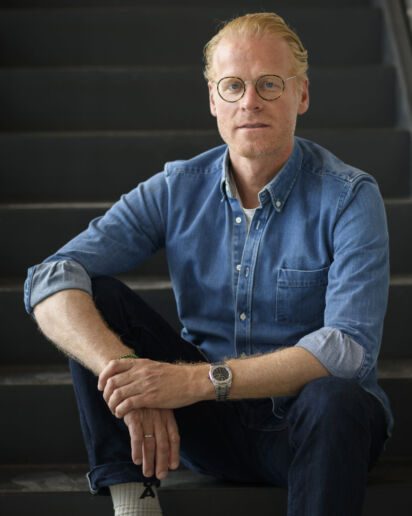
The fashion industry and the corresponding trade show landscape – especially in Germany – are currently in a phase of upheaval. As the organiser of MUNICH FABRIC START, how do you see your role in this context?
Sebastian Klinder: As a platform for high-quality fabrics and materials, MUNICH FABRIC START plays a central role in the German fashion landscape. We want to create the ideal environment for business with a high-quality, comprehensive exhibitor portfolio and the right scheduling. Our aim is not to set trends, but to reflect the most relevant ones, thereby strengthening the entire value chain and driving the development of the industry. With our holistic ecosystem consisting of Fabrics, Additionals, Bluezone, Per4mance, ReSource, Design Studios, Keyhouse, Sustainable Innovations and The Source, we fulfil this aspiration at MUNICH FABRIC START. Through targeted coordination with the industry, we offer an ideal atmosphere in which future-oriented players can come together.
Frank Junker: MUNICH FABRIC START is a creative hub that gives designers space to bring their ideas to life. We see ourselves as trailblazers for creative and technological innovations and thus as a driving force for the further development of the fashion industry. In this context, the topic of sustainability, for example, is firmly anchored in the program of our events. In addition, we attach great importance to our range of trend forums and presentations in order to be able to offer our guests the most holistic, future-oriented program possible, which serves the need for orientation and inspiration in equal measure and, last but not least, brings the entire industry together for exchange, networking and get-togethers.
